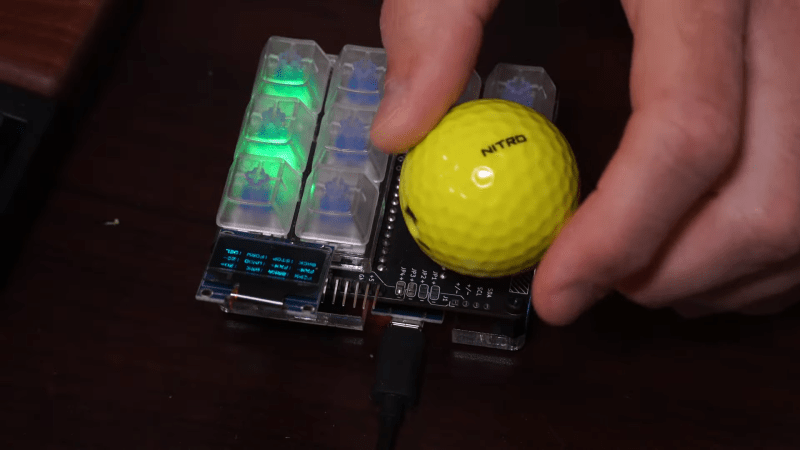Golf balls are wonderfully tactile things. They have a semi-grippy covering, and they’re a beautiful size and weight that sits nicely in the hand. Sadly, most of them just get smacked away with big metal clubs. [Jeremy Cook] recognized their value as a human interface device, though, and set about turning one into a useful volume knob.
The trick here is in the machining. [Jeremy] used a 3D printed jig to hold a golf ball tightly in place so that it could be machined using a milling machine. With the bottom taken off and a carefully-designed 3D printed insert in the bottom, the golf ball is ready to be used as a knob for a volume control. As for the hardware side of things, [Jeremy] used an existing USB keypad, fitting the golf ball onto the encoder for volume and seek control in various programs.
The results sadly weren’t ideal. While the golf ball sits nicely upon the encoder, [Jeremy] found the device uncomfortable to use. Size may be an issue, but we also suspect the crowding of the surrounding buttons has a role to play. It forces the wrist into an uncomfortable curve to access the ball without hitting the surrounding controls. Without that, it may be greatly improved.
Files are available for those wishing to make their own. We don’t get a lot of golf ball builds here on Hackaday, but we’d love to see more. Hit up the tipsline if you’ve got ’em. Video after the break.
















Why not just 3D print a knob? Brass shaft inserts with set screws are cheap and can be installed with the tip of a soldering iron. A sphere like a golf ball might be the least desirable shape I could imagine for a knob.
I thought at first it was for a trackball, but no, he just cut it in half…
It is what they wanted? And by that argument just buy a knob off the shelf – even easier than the brass inserts.
A golf ball already has a great tactile surface finish and, because it has to be, is made from hugely durable and chemically stable materials – much as 3d printing is magical you don’t so trivially get all those things from a 3d printer.
If the surface finish of a well tuned FDM printer is to you requirements it makes a good choice to print a knob, but it won’t so easily get this style of surface finish. Tactile feel of a 3d print, even a good one I’d not say is great. And the UV cure Resins that can more successfully print extra fine details and surface finish directly often don’t do well around people or less controlled environments – many of them warp or get sticky, absorb oil and water, degrade rather quickly, and most of them are rather brittle – trying to directly print in resin that final finish object for such a role would take lots of research for the right resin blend, and probably more than a few reprints in a months time as that last resin it turns out isn’t good enough.
There are of course things you can do post printing to help – like vapour smoothing. But that is a whole other complex process to really master you put on yourself.
One wonders what the stresses being put on the board component(and subsequently the board itself) that the golf ball is attached to…
Or the stresses incurred to the PCB each time someone whacks it with a golf club.
Is that now the standard way all golf balls are filled internally, or did he just get lucky? Last time I destroyed a golf ball (a long time ago) the internals could best be described as a small squishy core wrapped in miles of elastic. Would likely have resulted in an unuseable mess if machined the way he did.
I was expecting a mess too, all the ones I tool apart as a kid had a small rubber bag of paint wrapped in elastic, and pretty much exploded when you cut them.
Which was rather the point of taking them apart, really.
Interesting.
I had a PC case with a half golf ball as power button. I don’t think it was a real golf ball, but was the same texture and size.
https://i.imgur.com/1l4jGum.jpeg
Thanks so much for the writeup!
But can it go to 11?
It can make it through all 18 holes if you avoid the rough and water hazards.